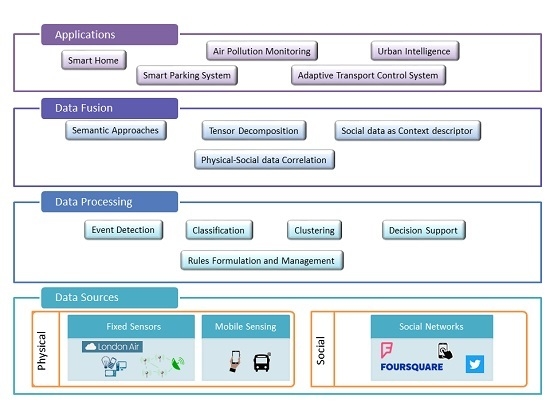Cyber–Physical–Social Frameworks for Urban Big Data Systems: A Survey
Abstract
1. Introduction
- A conceptual framework for urban CPSS from the data perspective, based on the recognition, in current state of the art [29,46,47], of the need for multitier computation and abstraction methods (along the lines of the data–information–knowledge–wisdom (DIKW) pyramid proposed in [29]) to meet the challenges of dealing with big data in urban CPSS.
- An analysis of the state-of-the-art data analytics and cross-space data fusion methods for integrating sensor data with social intelligence.
- Categorizations of techniques adopted by existing works relevant to the different layers of the identified conceptual framework.
2. Background of Cyber–Physical–Social Systems
3. Data-Centric Cyber–Physical–Social Urban Big Data Systems
- Collaborative sensing sources: since different sources may provide data about the same physical resource (i.e., location, phenomenon, etc.) from different aspects due to their inherent capabilities, the resulting data must be combined to achieve collaborative sensing. Smartphone-carrying citizens are valuable sensing resources due to their inherent mobility around different parts of a city, together with observations made by citizens on online social networks about specific city-relevant situations. Citizen-contributed data can be a cooperative source of relevant data to complement that obtained from physical sensor networks.
- Data analysis: in addition to preliminary steps such as data cleaning, redundancy elimination, etc., data analysis should consider the inherent correlation between the data from different spaces (i.e., online or physical world) through detection of patterns and thematic–spatiotemporal context relevance [58]. Thematic–spatiotemporal context awareness consists of associating the physical world numerical sensing data with external influencing information (e.g., locations, time, events that may influence sensed data), since urban data is often highly localized.
- Cross-space data fusion: with the multimodal data collected from heterogeneous data sources, advanced mining techniques are needed to fuse the data which may be in different scales of measurement [59], for instance, physical sensor data which is usually in interval or ratio scale (involving quantitative variables) and open datasets which correspond to nominal or ordinal scale (involving qualitative classifications).
A Taxonomy and Conceptual Framework for CPSS Solutions
4. Data Sources
4.1. Physical Sensor Deployments
4.2. Mobile Crowd Sensing
4.2.1. Participatory Sensing
4.2.2. User-Contributed Data from Online Social Networks
4.3. CPSS Elements as Abstract Concepts
5. Data Processing
5.1. Rule Formulation and Management
5.2. Clustering and Classification of Data Streams
5.3. Event Detection
5.4. Decision Support
6. Data Fusion
6.1. Tensor Decomposition
6.2. Semantic Reasoning
6.3. Social Intelligence as Context Descriptor
6.4. Cross-Space Data Fusion through Correlation
7. CPSS Applications
7.1. Smart Home
7.2. Urban Intelligence
7.3. Intelligent Transportation Systems (ITS)
7.4. Environmental Monitoring
8. Discussion
9. Conclusions
Acknowledgments
Author Contributions
Conflicts of Interest
References
- Zeng, J.; Yang, L.T.; Lin, M.; Ning, H.; Ma, J. A survey: Cyber-physical-social systems and their system-level design methodology. Future Gener. Comput. Syst. 2016. [Google Scholar] [CrossRef]
- Ning, H.; Liu, H.; Ma, J.; Yang, L.T.; Huang, R. Cybermatics: Cyber–physical–social–thinking hyperspace based science and technology. Future Gener. Comput. Syst. 2016, 56, 504–522. [Google Scholar] [CrossRef]
- Zhuge, H. Cyber-Physical Society—The science and engineering for future society. Future Gener. Comput. Syst. 2014, 32, 180–186. [Google Scholar] [CrossRef]
- Bordel, B.; Alcarria, R.; Robles, T.; Martín, D. Cyber–physical systems: Extending pervasive sensing from control theory to the Internet of Things. Perv. Mob. Comput. 2017, 40, 156–184. [Google Scholar] [CrossRef]
- Conti, M.; Passarella, A.; Das, S.K. The Internet of People (IoP): A new wave in pervasive mobile computing. Perv. Mob. Comput. 2017, 41, 1–27. [Google Scholar] [CrossRef]
- Lee, E.A. Cyber Physical Systems: Design Challenges. In Proceedings of the 11th IEEE International Symposium on Object and Component-Oriented Real-Time Distributed Computing (ISORC), Orlando, FL, USA, 5–7 May 2008; pp. 363–369. [Google Scholar]
- Nunes, D.S.; Zhang, P.; Silva, J.S. A Survey on Human-in-the-Loop Applications towards an Internet of All. IEEE Commun. Surv. Tutor. 2015, 17, 944–965. [Google Scholar] [CrossRef]
- Othman, M.F.; Shazali, K. Wireless Sensor Network Applications: A Study in Environment Monitoring System. Procedia Eng. 2012, 41, 1204–1210. [Google Scholar] [CrossRef]
- Posnicek, T.; Kellner, K.; Brandl, M. Wireless Sensor Network for Environmental Monitoring with 3G Connectivity. Procedia Eng. 2014, 87, 524–527. [Google Scholar] [CrossRef]
- Dunfan, Y.; Daoli, G.; Wei, W. Application of wireless sensor networks in environmental monitoring. In Proceedings of the 2009 2nd International Conference on Power Electronics and Intelligent Transportation System (PEITS), Shenzhen, China, 19–20 December 2009; pp. 205–208. [Google Scholar]
- Smirnov, A.; Kashevnik, A.; Ponomarev, A. Multi-level Self-organization in Cyber-Physical-Social Systems: Smart Home Cleaning Scenario. Procedia CIRP 2015, 30, 329–334. [Google Scholar] [CrossRef]
- London Air Quality Network. Available online: https://www.londonair.org.uk/LondonAir/Default.aspx (accessed on 8 August 2017).
- Guo, B.; Wang, Z.; Yu, Z.; Wang, Y.; Yen, N.Y.; Huang, R.; Zhou, X. Mobile Crowd Sensing and Computing: The Review of an Emerging Human-Powered Sensing Paradigm. ACM Comput. Surv. 2015, 48, 1–31. [Google Scholar] [CrossRef]
- Sanchez, L.M.L.; Galache, J.A.; Sotres, P.; Santana, J.R.; Gutierrez, V.; Ramdhany, R.; Gluhak, A.; Krco, S.; Theodoridis, E. Smartsantander: Iot experimentation over a smart city testbed. Comput. Netw. 2014, 61, 217–238. [Google Scholar] [CrossRef]
- Kang, L.; Poslad, S.; Wang, W.; Li, X.; Zhang, Y.; Wang, C. A Public Transport Bus as a Flexible Mobile Smart Environment Sensing Platform for IoT. In Proceedings of the 2016 12th International Conference on Intelligent Environments (IE), London, UK, 14–16 September 2016; pp. 1–8. [Google Scholar]
- Zhou, Y.; De, S.; Wang, W.; Moessner, K. Enabling Query of Frequently Updated Data from Mobile Sensing Sources. In Proceedings of the 13th IEEE International Conference on Ubiquitous Computing and Communications (IUCC 2014), Chengdu, China, 19–21 December 2014; IEEE Computer Society: Chengdu, China, 2014. [Google Scholar]
- Conti, M.; Das, S.K.; Bisdikian, C.; Kumar, M.; Ni, L.M.; Passarella, A.; Roussos, G.; Tröster, G.; Tsudik, G.; Zambonelli, F. Looking ahead in pervasive computing: Challenges and opportunities in the era of cyber–physical convergence. Perv. Mob. Comput. 2012, 8, 2–21. [Google Scholar] [CrossRef]
- Jin, J.; Gubbi, J.; Marusic, S.; Palaniswami, M. An information framework for creating a smart city through Internet of things. IEEE Intern. Things J. 2014, 1, 112–121. [Google Scholar] [CrossRef]
- Guo, W.; Zhang, Y.; Li, L. The integration of CPS, CPSS, and ITS: A focus on data. Tsinghua Sci. Technol. 2015, 20, 327–335. [Google Scholar] [CrossRef]
- Anantharam, P.; Barnaghi, P.; Thirunarayan, K.; Sheth, A. Extracting City Traffic Events from Social Streams. ACM Trans. Intell. Syst. Technol. 2015, 6, 1–27. [Google Scholar] [CrossRef]
- Zhou, Y.; De, S.; Moessner, K. Real World City Event Extraction from Twitter Data Streams. Procedia Comput. Sci. 2016, 98, 443–448. [Google Scholar] [CrossRef]
- Sakaki, T.; Okazaki, M.; Matsuo, Y. Earthquake shakes Twitter users: Real-time event detection by social sensors. In Proceedings of the 19th International Conference on World Wide Web, Raleigh, NC, USA, 26–30 April 2010; pp. 851–860. [Google Scholar]
- Cranshaw, J.; Schwartz, R.; Hong, J.I.; Sadeh, N. The Livehoods Project: Utilizing Social Media to Understand the Dynamics of a City. In Proceedings of the International AAAI Conference on Web and Social Media (ICWSM), Dublin, Ireland, 4–7 June 2012. [Google Scholar]
- Zhang, A.X.; Noulas, A.; Scellato, S.; Mascolo, C. Hoodsquare: Modeling and Recommending Neighborhoods in Location-Based Social Networks. In Proceedings of the International Conference on Social Computing (SocialCom), Washington, DC, USA, 8–14 September 2013. [Google Scholar]
- Noulas, A.; Scellato, S.; Mascolo, C.; Pontil, M. Exploiting Semantic Annotations for Clustering Geographic Areas and Users in Location-based Social Networks. In Proceedings of the Social Mobile Web, AAAI Workshops, Barcelona, Catalonia, Spain, 21 July 2011. [Google Scholar]
- Silva, T.H.; Melo, P.O.S.V.D.; Almeida, J.M.; Salles, J.; Loureiro, A.A.F. Revealing the City That We Cannot See. ACM Trans. Internet Technol. 2014, 14, 1–23. [Google Scholar] [CrossRef]
- Yuan, J.; Zheng, Y.; Xie, X. Discovering regions of different functions in a city using human mobility and POIs. In Proceedings of the 18th ACM SIGKDD International Conference on Knowledge Discovery and Data Mining, Beijing, China, 12–16 August 2012; pp. 186–194. [Google Scholar]
- Wang, F.Y. The Emergence of Intelligent Enterprises: From CPS to CPSS. IEEE Intell. Syst. 2010, 25, 85–88. [Google Scholar] [CrossRef]
- Sheth, A.; Anantharam, P.; Henson, C. Physical-Cyber-Social Computing: An Early 21st Century Approach. IEEE Intell. Syst. 2013, 28, 78–82. [Google Scholar] [CrossRef]
- Liu, Z.; Yang, D.S.; Wen, D.; Zhang, W.M.; Mao, W. Cyber-Physical-Social Systems for Command and Control. IEEE Intell. Syst. 2011, 26, 92–96. [Google Scholar] [CrossRef]
- Kuznetsov, S.; Davis, G.; Cheung, J.; Paulos, E. Ceci n’est pas une pipe bombe: Authoring urban landscapes with air quality sensors. In Proceedings of the Sigchi Conference on Human Factors in Computing Systems, Vancouver, BC, Canada, 7–12 May 2011; pp. 2375–2384. [Google Scholar]
- Du, X.; Emebo, O.; Varde, A.; Tandon, N.; Chowdhury, S.N.; Weikum, G. Air quality assessment from social media and structured data: Pollutants and health impacts in urban planning. In Proceedings of the 2016 IEEE 32nd International Conference on Data Engineering Workshops (ICDEW), Helsinki, Finland, 16–20 May 2016; pp. 54–59. [Google Scholar]
- Zhou, C.; Dai, P.; Wang, F.; Zhang, Z. Predicting the passenger demand on bus services for mobile users. Perv. Mob. Comput. 2016, 25, 48–66. [Google Scholar] [CrossRef]
- Frazzon, E.M.; Hartmann, J.; Makuschewitz, T.; Scholz-Reiter, B. Towards Socio-Cyber-Physical Systems in Production Networks. Procedia CIRP 2013, 7, 49–54. [Google Scholar] [CrossRef]
- Ding, K.; Jiang, P. Incorporating Social Sensors and CPS Nodes for Personalized Production under Social Manufacturing Environment. Procedia CIRP 2016, 56, 366–371. [Google Scholar] [CrossRef]
- Anagnostopoulos, T.; Ferreira, D.; Samodelkin, A.; Ahmed, M.; Kostakos, V. Cyclist-aware traffic lights through distributed smartphone sensing. Perv. Mob. Comput. 2016, 31, 22–36. [Google Scholar] [CrossRef]
- Digiesi, S.; Facchini, F.; Mossa, G.; Mummolo, G.; Verriello, R. A Cyber—Based DSS for a Low Carbon Integrated Waste Management System in a Smart City. IFAC PapersOnLine 2015, 48, 2356–2361. [Google Scholar] [CrossRef]
- Costanzo, A.; Faro, A.; Giordano, D.; Spampinato, C. An ontological ubiquitous city information platform provided with Cyber-Physical-Social-Systems. In Proceedings of the 13th IEEE Annual Consumer Communications & Networking Conference (CCNC), Las Vegas, NV, USA, 9–12 January 2016; pp. 137–144. [Google Scholar]
- Costanzo, A.; Faro, A.; Giordano, D.; Spampinato, C. Implementing Cyber Physical social Systems for smart cities: A semantic web perspective. In Proceedings of the 13th IEEE Annual Consumer Communications & Networking Conference (CCNC), Las Vegas, NV, USA, 9–12 January 2016; pp. 274–275. [Google Scholar]
- Guo, B.; Yu, Z.; Zhou, X. A Data-Centric Framework for Cyber-Physical-Social Systems. IT Prof. 2015, 17, 4–7. [Google Scholar] [CrossRef]
- Jayaraman, P.P.; Gomes, J.B.; Nguyen, H.L.; Abdallah, Z.S.; Krishnaswamy, S.; Zaslavsky, A. Scalable Energy-Efficient Distributed Data Analytics for Crowdsensing Applications in Mobile Environments. IEEE Trans. Comput. Soc. Syst. 2015, 2, 109–123. [Google Scholar] [CrossRef]
- Kuang, L.; Yang, L.; Liao, Y. An Integration Framework on Cloud for Cyber Physical Social Systems Big Data. IEEE Trans. Cloud Comput. 2015. [Google Scholar] [CrossRef]
- Misra, S.; Goswami, S.; Taneja, C. Multivariate Data Fusion-Based Learning of Video Content and Service Distribution for Cyber Physical Social Systems. IEEE Trans. Comput. Soc. Syst. 2016, 3, 1–12. [Google Scholar] [CrossRef]
- Hehenberger, P.; Vogel-Heuser, B.; Bradley, D.; Eynard, B.; Tomiyama, T.; Achiche, S. Design, modelling, simulation and integration of cyber physical systems: Methods and applications. Comput. Ind. 2016, 82, 273–289. [Google Scholar] [CrossRef]
- Shih, C.S.; Chou, J.J.; Reijers, N.; Kuo, T.W. Designing CPS/IoT applications for smart buildings and cities. IET Cyber Phys. Syst. Theory Appl. 2016, 1, 3–12. [Google Scholar] [CrossRef]
- Salim, F.; Haque, U. Urban computing in the wild: A survey on large scale participation and citizen engagement with ubiquitous computing, cyber physical systems, and Internet of Things. Int. J. Hum. Comput. Stud. 2015, 81, 31–48. [Google Scholar] [CrossRef]
- Zheng, Y.; Capra, L.; Wolfson, O.; Yang, H. Urban Computing: Concepts, Methodologies, and Applications. ACM Trans. Intell. Syst. Technol. 2014, 5, 1–55. [Google Scholar] [CrossRef]
- Moldovan, D.; Copil, G.; Dustdar, S. Elastic systems: Towards cyber-physical ecosystems of people, processes, and things. Comput. Stand. Interfaces 2017. [Google Scholar] [CrossRef]
- Harashima, F.; Tomizuka, M.; Fukuda, T. Mechatronics—“What Is It, Why, and How?” An editorial. IEEE/ASME Trans. Mech. 1996, 1, 1–4. [Google Scholar] [CrossRef]
- Institute of Mechatronic Systems, Vehicle Vibration Analysis and Compensation. Available online: https://www.imes.uni-hannover.de/36.html?&L=1&tx_tkforschungsberichte_pi1%5BshowUid%5D=495&tx_tkforschungsberichte_pi1%5Bbackpid%5D=11&tx_tkforschungsberichte_pi1%5Btx_tkinstpersonen_pi1-showUid%5D=81&tx_tkforschungsberichte_pi1%5Btx_tkinstpersonen_pi1-projekte%5D=1&cHash=edd1b837fe36bed5a708b18274432e42 (accessed on 8 September 2017).
- Lin, C.C.; Deng, D.J.; Jhong, S.Y. A Triangular NodeTrix Visualization Interface for Overlapping Social Community Structures of Cyber-Physical-Social Systems in Smart Factories. IEEE Trans. Emerg. Top. Comput. 2017. [Google Scholar] [CrossRef]
- Fan, X.; Huang, H.; Qi, S.; Luo, X.; Zeng, J.; Xie, Q.; Xie, C. Sensing Home: A Cost-Effective Design for Smart Home via Heterogeneous. Wirel. Netw. Sens. 2015, 15, 29797. [Google Scholar]
- Beigl, M.; Gellersen, H.-W.; Schmidt, A. Mediacups: Experience with design and use of computer-augmented everyday artefacts. Comput. Netw. 2001, 35, 401–409. [Google Scholar] [CrossRef]
- Lee, I.; Sokolsky, O.; Chen, S.; Hatcliff, J.; Jee, E.; Kim, B.; King, A.; Mullen-Fortino, M.; Park, S.; Roederer, A.; et al. Challenges and Research Directions in Medical Cyber-Physical Systems. Proc. IEEE 2012, 100, 75–90. [Google Scholar]
- Smirnov, A.; Levashova, T.; Shilov, N.; Sandkuhl, K. Ontology for cyber-physical-social systems self-organisation. In Proceedings of the 16th Conference of Open Innovations Association FRUCT, Oulu, Finland, 27–31 October 2014; pp. 101–107. [Google Scholar]
- Puiu, D.; Barnaghi, P.; Tönjes, R.; Kümper, D.; Ali, M.I.; Mileo, A.; Parreira, J.X.; Fischer, M.; Kolozali, S.; Farajidavar, N.; et al. CityPulse: Large Scale Data Analytics Framework for Smart Cities. IEEE Access 2016, 4, 1086–1108. [Google Scholar] [CrossRef]
- Komninos, A.; Stefanis, V.; Plessas, A.; Besharat, J. Capturing Urban Dynamics with Scarce Check-In Data. Perv. Comput. IEEE 2013, 12, 20–28. [Google Scholar] [CrossRef]
- De, S.; Christophe, B.; Moessner, K. Semantic Enablers for Dynamic Digital-Physical Object Associations in a Federated Node Architecture for the Internet of Things. Ad Hoc Netw. 2014, 18, 102–120. [Google Scholar] [CrossRef]
- Stevens, S.S. On the Theory of Scales of Measurement. Science 1946, 103, 677–680. [Google Scholar] [CrossRef] [PubMed]
- Fielding, R.T. Architectural Styles and the Design of Network-based Software Architectures; University of California: Irvine, CA, USA, 2000. [Google Scholar]
- IETF. The Constrained Application Protocol (CoAP); In Request for Comments; Universitaet Bremen: Bremen, Germany, 2014; Volume 7252. [Google Scholar]
- Zhou, Y.; De, S.; Wang, W.; Moessner, K.; Palaniswami, M. Spatial Indexing for Data Searching in Mobile Sensing Environments. Sensors 2017, 17, 1427. [Google Scholar] [CrossRef] [PubMed]
- Jara, A.J.; Genoud, D.; Bocchi, Y. Big data for smart cities with KNIME a real experience in the SmartSantander testbed. Softw. Pract. Exp. 2015, 45, 1145–1160. [Google Scholar] [CrossRef]
- Noulas, A.; Mascolo, C.; Frias-Martinez, E. Exploiting Foursquare and Cellular Data to Infer User Activity in Urban Environments. In Proceedings of the IEEE 14th International Conference on Mobile Data Management, Milan, Italy, 3–6 June 2013; Volume 1, pp. 167–176. [Google Scholar]
- Yang, B.; Castell, N.; Pei, J.; Du, Y.; Gebremedhin, A.; Kirkevold, Ø. Towards Crowd-Sourced Air Quality and Physical Activity Monitoring by a Low-Cost Mobile Platform. In Proceedings of the International Conference on Smart Homes and Health Telematics, Wuhan, China, 25–27 May 2016; pp. 451–463. [Google Scholar]
- Zhang, Y. GroRec: A Group-Centric Intelligent Recommender System Integrating Social, Mobile and Big Data Technologies. IEEE Trans. Serv. Comput. 2016, 9, 786–795. [Google Scholar] [CrossRef]
- Wang, X.; Yang, L.T.; Feng, J.; Chen, X.; Deen, M.J. A Tensor-Based Big Service Framework for Enhanced Living Environments. IEEE Cloud Comput. 2016, 3, 36–43. [Google Scholar] [CrossRef]
- Candra, Z.C.M.; Truong, H.L.; Dustdar, S. On Monitoring Cyber-Physical-Social Systems. In Proceedings of the IEEE World Congress on Services (SERVICES), San Francisco, CA, USA, 27 June–2 July 2016; pp. 56–63. [Google Scholar]
- Hussein, D.; Park, S.; Han, S.N.; Crespi, N. Dynamic Social Structure of Things: A Contextual Approach in CPSS. IEEE Intern. Comput. 2015, 19, 12–20. [Google Scholar] [CrossRef]
- Szabó, R.; Farkas, K.; Ispány, M.; Benczur, A.A.; Bátfai, N.; Jeszenszky, P.; Laki, S.; Vágner, A.; Kollár, L.; Sidló, C. Framework for smart city applications based on participatory sensing. In Proceedings of the IEEE 4th International Conference on Cognitive Infocommunications (CogInfoCom), Budapest, Hungary, 2–5 December 2013; pp. 295–300. [Google Scholar]
- Difallah, D.E.; Cudré-Mauroux, P.; McKenna, S.A. Scalable Anomaly Detection for Smart City Infrastructure Networks. IEEE Intern. Comput. 2013, 17, 39–47. [Google Scholar] [CrossRef]
- Lécué, F.T.-D.S.; Hayes, J.; Tucker, R.; Bicer, V.; Sbodio, M.; Tommasi, P. Smart traffic analytics in the semantic web with star-city: Scenarios, system and lessons learned in dublin city. Web Semant. Sci. Serv. Agents World Wide Web 2014, 27–28, 26–33. [Google Scholar] [CrossRef]
- Theodoridis, E.M.G.; Chatzigiannakis, I. Developing an iot smart city framework. In Proceedings of the Fourth International Conference on Information, Intelligence, Systems and Applications (IISA), Piraeus, Greece, 10–12 July 2013. [Google Scholar]
- Cleanspace tag. Available online: https://our.clean.space/ (accessed on 8 August 2017).
- How Smart City Barcelona Brought the Internet of Things to Life. Available online: http://datasmart.ash.harvard.edu/news/article/how-smart-city-barcelona-brought-the-internet-of-things-to-life-789 (accessed on 8 August 2017).
- SmartThings. Available online: http://docs.smartthings.com/en/latest/architecture/ (accessed on 5 August 2017).
- Nest. Available online: https://nest.com/ (accessed on 5 August 2017).
- Delmastro, F.; Arnaboldi, V.; Conti, M. People-centric computing and communications in smart cities. IEEE Commun. Mag. 2016, 54, 122–128. [Google Scholar] [CrossRef]
- Campbell, A.T.; Eisenman, S.B.; Lane, N.D.; Miluzzo, E.; Peterson, R.A. People-centric urban sensing. In Proceedings of the 2nd Annual International Workshop on Wireless Internet, Boston, MA, USA, 2–5 August 2006; p. 18. [Google Scholar]
- Sowe, S.K.; Simmon, E.; Zettsu, K.; Vaulx, F.D.; Bojanova, I. Cyber-Physical-Human Systems: Putting People in the Loop. IT Prof. 2016, 18, 10–13. [Google Scholar] [CrossRef] [PubMed]
- Cervigón, P.; Gutiérrez, M.; Díaz, J.; Aránguez, E. Forecasting for Poaceae pollen with temporal series by applying ARIMA predictive model. In Proceedings of the 7th International Congress Aerobiology, Montebello, QC, Canada, 5–9 August 2002. [Google Scholar]
- Barcelona Digital City—Sentilo. Available online: http://ajuntament.barcelona.cat/digital/en/digital-transformation/urban-technology/sentilo (accessed on 5 August 2017).
- Burke, J.A.; Estrin, D.; Hansen, M.; Parker, A.; Ramanathan, N.; Reddy, S.; Srivastava, M.B. Participatory Sensing; Center for Embedded Network Sensing: Los Angeles, CA, USA, 2006. [Google Scholar]
- Lane, N.D.; Eisenman, S.B.; Musolesi, M.; Miluzzo, E.; Campbell, A.T. Urban sensing systems: Opportunistic or participatory? In Proceedings of the 9th Workshop on Mobile Computing Systems and Applications, Napa Valley, CA, USA, 25–26 February 2008; pp. 11–16. [Google Scholar]
- eMarketers. Nearly One-Third of the World Will Use Social Networks Regularly This Year. Available online: https://www.emarketer.com/Article/Nearly-One-Third-of-World-Will-Use-Social-Networks-Regularly-This-Year/1014157#sthash.6swVYg2Q.dpuf (accessed on 5 August 2017).
- Twitter. Available online: https://twitter.com/?lang=en-gb (accessed on 5 July 2017).
- Foursquare. Available online: https://foursquare.com/ (accessed on 19 July 2017).
- Morstatter, F.; Pfeffer, J.; Liu, H.; Carley, K.M. Is the Sample Good Enough? Comparing Data from Twitter’s Streaming API with Twitter’s Firehose. In Proceedings of the ICWSM, Cambridge, MA, USA, 8–11 July 2013. [Google Scholar]
- Pan, B.; Zheng, Y.; Wilkie, D.; Shahabi, C. Crowd sensing of traffic anomalies based on human mobility and social media. In Proceedings of the 21st ACM SIGSPATIAL International Conference on Advances in Geographic Information Systems, Orlando, FL, USA, 5–8 November 2013; pp. 344–353. [Google Scholar]
- Wang, W.; De, S.; Zhou, Y.; Huang, X.; Moessner, K. Distributed sensor data computing in smart city applications. In Proceedings of the IEEE 18th International Symposium on A World of Wireless, Mobile and Multimedia Networks (WoWMoM), Macau, China, 12–15 June 2017; pp. 1–5. [Google Scholar]
- OCF Specification 1.0. Available online: https://openconnectivity.org/developer/specifications (accessed on 5 July 2017).
- Web of Things Model. Available online: https://www.w3.org/Submission/wot-model/ (accessed on 5 July 2017).
- Ester, M.; Kriegel, H.-P.; Sander, J.; Xu, X. A density-based algorithm for discovering clusters a density-based algorithm for discovering clusters in large spatial databases with noise. In Proceedings of the Second International Conference on Knowledge Discovery and Data Mining, Portland, OR, USA, 2–4 August 1996; pp. 226–231. [Google Scholar]
- Yang, S.; Cheema, M.A.; Lin, X.; Wang, W. Reverse k nearest neighbors query processing: Experiments and analysis. Proc. VLDB Endow. 2015, 8, 605–616. [Google Scholar]
- Zheng, Y.; Zhang, H.; Yu, Y. Detecting collective anomalies from multiple spatio-temporal datasets across different domains. In Proceedings of the 23rd SIGSPATIAL International Conference on Advances in Geographic Information Systems, Bellevue, WA, USA, 3–6 November 2015; pp. 1–10. [Google Scholar]
- Anselin, L. Local Indicators of Spatial Association—LISA. Geogr. Anal. 1995, 27, 93–115. [Google Scholar] [CrossRef]
- Cassandras, C.G. Smart Cities as Cyber-Physical Social Systems. Engineering 2016, 2, 156–158. [Google Scholar] [CrossRef]
- Zhou, Y.; De, S.; Wang, W.; Moessner, K. Search Techniques for the Web of Things: A Taxonomy and Survey. Sensors 2016, 16, 600. [Google Scholar] [CrossRef] [PubMed]
- Xue, Y.; Bogdan, P. Constructing compact causal mathematical models for complex dynamics. In Proceedings of the 8th International Conference on Cyber-Physical Systems, Pittsburgh, PA, USA, 18–21 April 2017; pp. 97–107. [Google Scholar]
- Xue, Y.; Rodriguez, S.; Bogdan, P. A spatio-temporal fractal model for a CPS approach to brain-machine-body interfaces. In Proceedings of the Design, Automation & Test in Europe Conference & Exhibition, Dresden, Germany, 14–18 March 2016; pp. 642–647. [Google Scholar]
- Ghorbani, M.; Bogdan, P. A cyber-physical system approach to artificial pancreas design. In Proceedings of the International Conference on Hardware/Software Codesign and System Synthesis (CODES+ISSS), Grenoble, France, 29 September–4 October 2013; pp. 1–10. [Google Scholar]
- Håkansson, A.; Hartung, R.; Moradian, E. Reasoning Strategies in Smart Cyber-Physical Systems. Procedia Comput. Sci. 2015, 60, 1575–1584. [Google Scholar] [CrossRef]
- Alippi, C.; Roveri, M. The (Not) Far-Away Path to Smart Cyber-Physical Systems: An Information-Centric Framework. Computer 2017, 50, 38–47. [Google Scholar] [CrossRef]
- Ditzler, G.; Roveri, M.; Alippi, C.; Polikar, R. Learning in Nonstationary Environments: A Survey. IEEE Comput. Intell. Mag. 2015, 10, 12–25. [Google Scholar] [CrossRef]
- W3C. PROV-O: The PROV Ontology. Available online: http://www.w3.org/TR/prov-o/ (accessed on 5 September 2017).
- Haddadi, H.; Howard, H.; Chaudhry, A.; Crowcroft, J.; Madhavapeddy, A.; McAuley, D.; Mortier, R. Personal Data: Thinking Inside the Box. In Proceedings of the 5th Decennial Aarhus Conferences, Aarhus, Denmark, 17–21 August 2015. [Google Scholar]
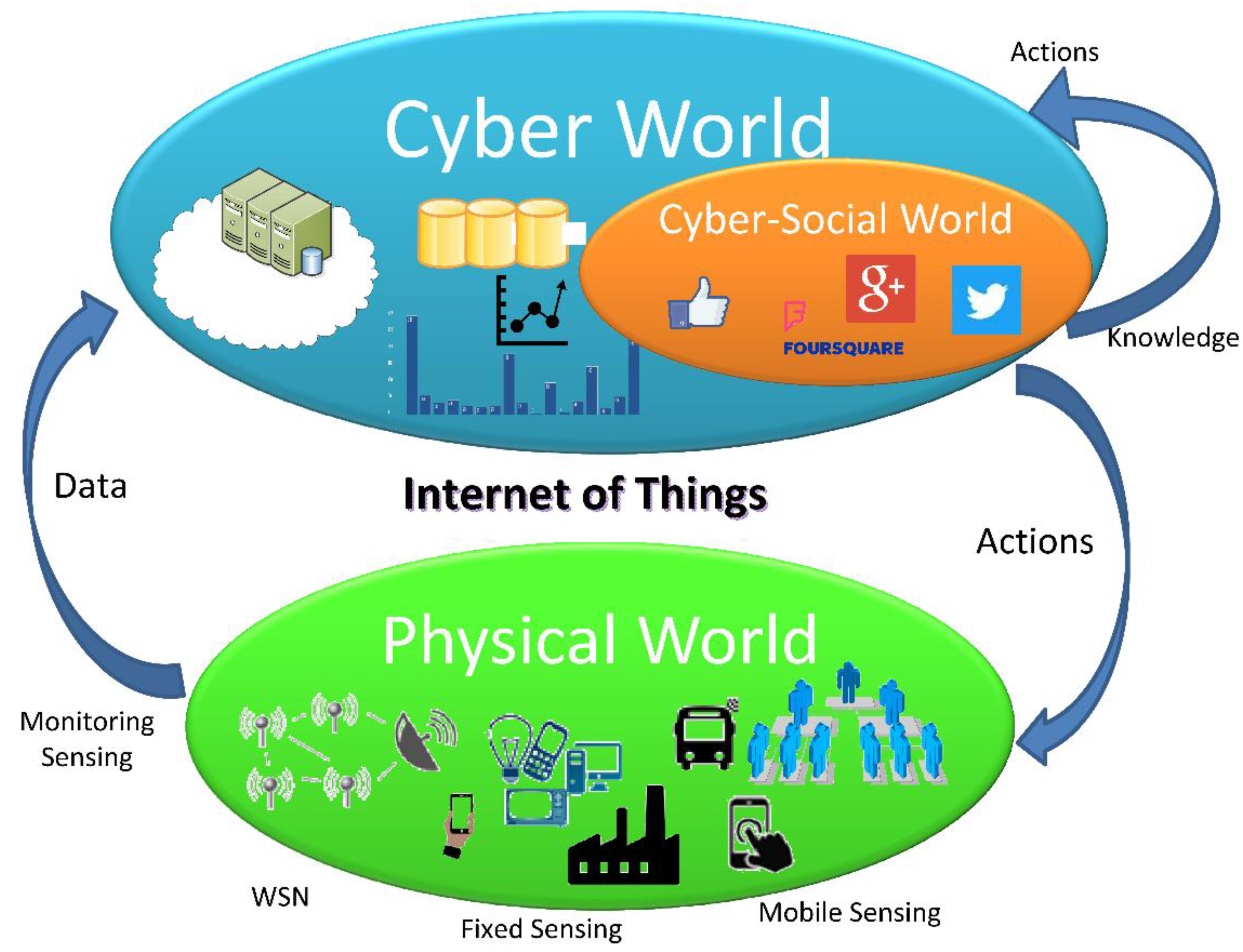
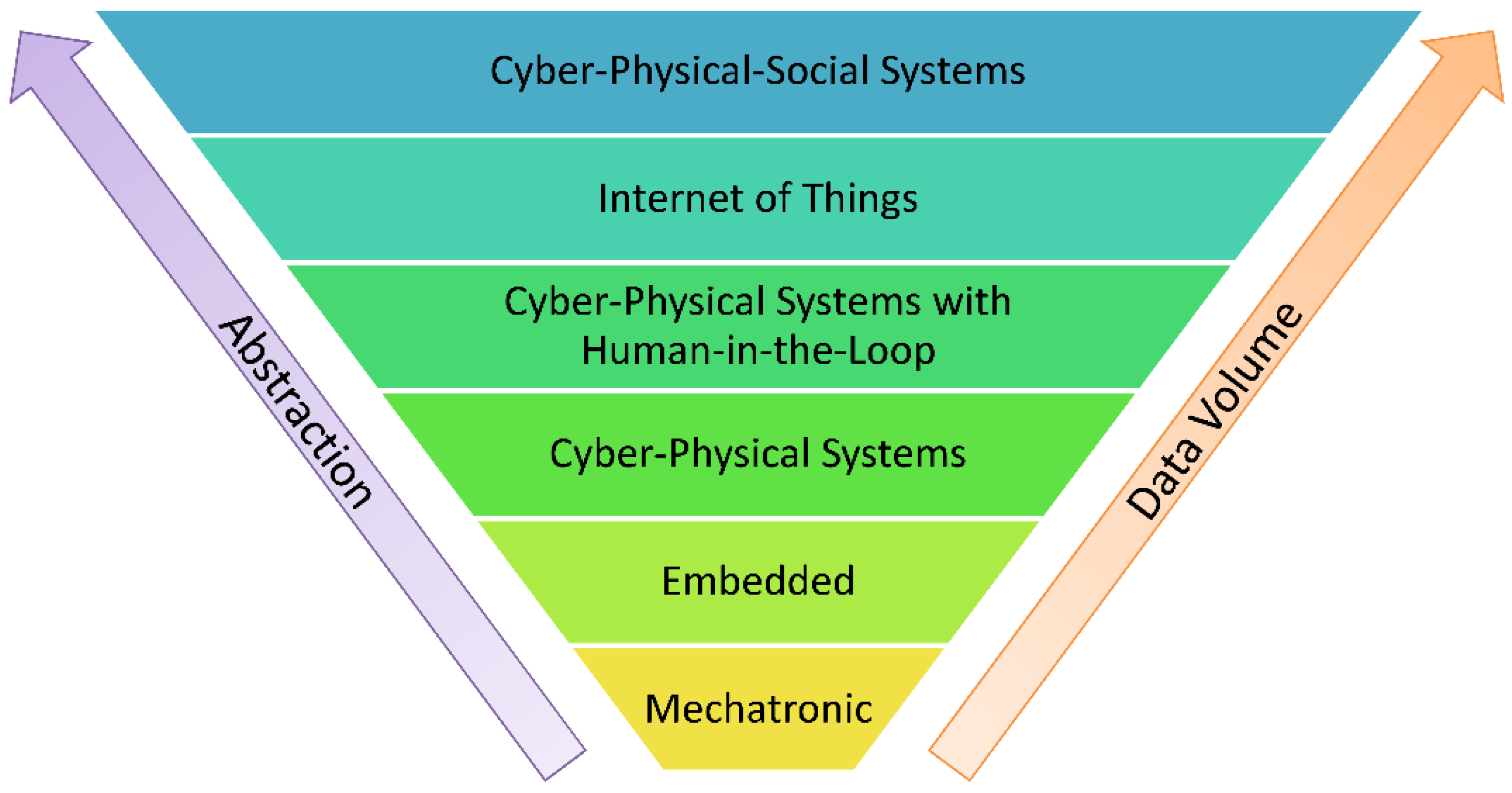
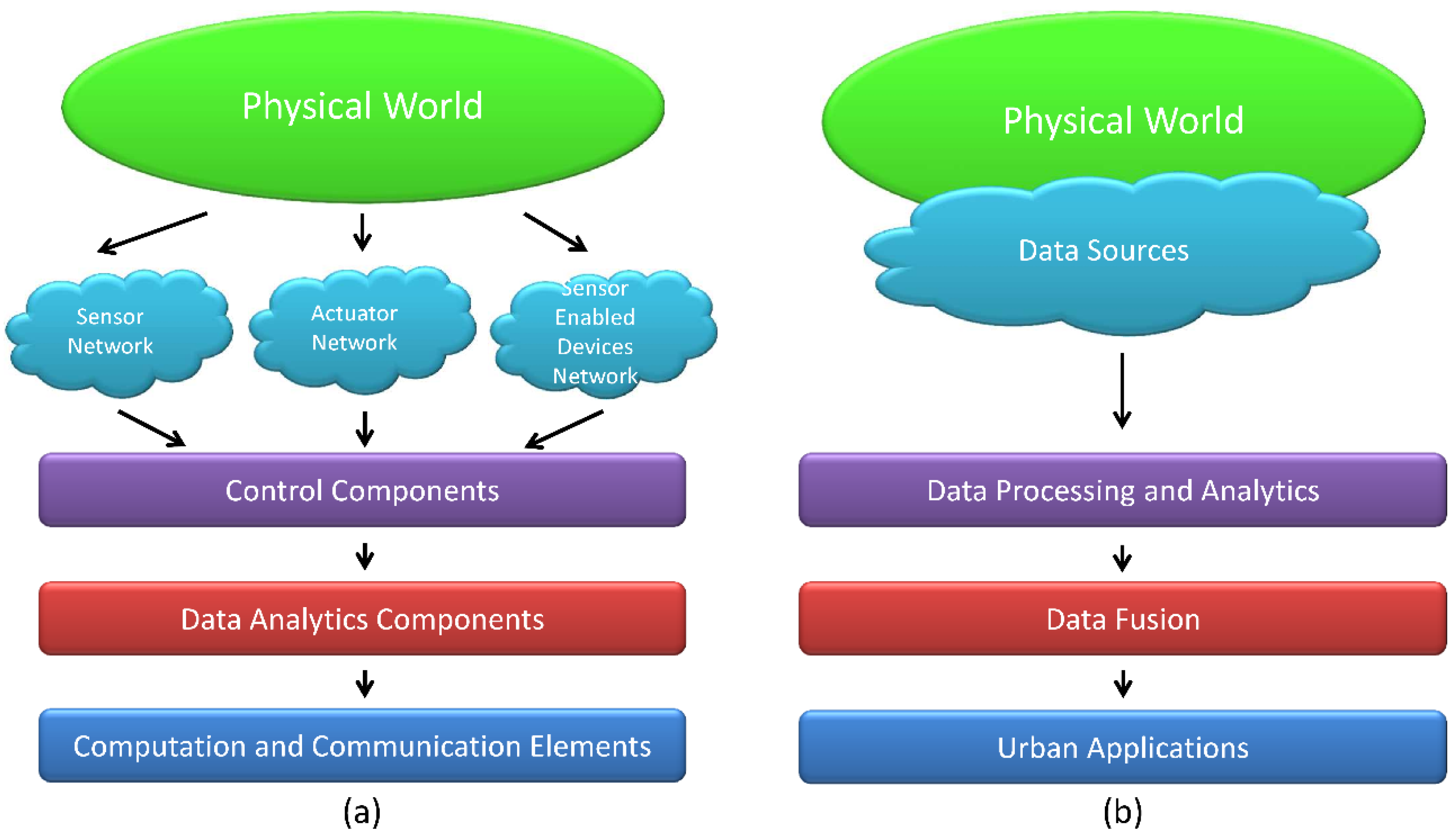
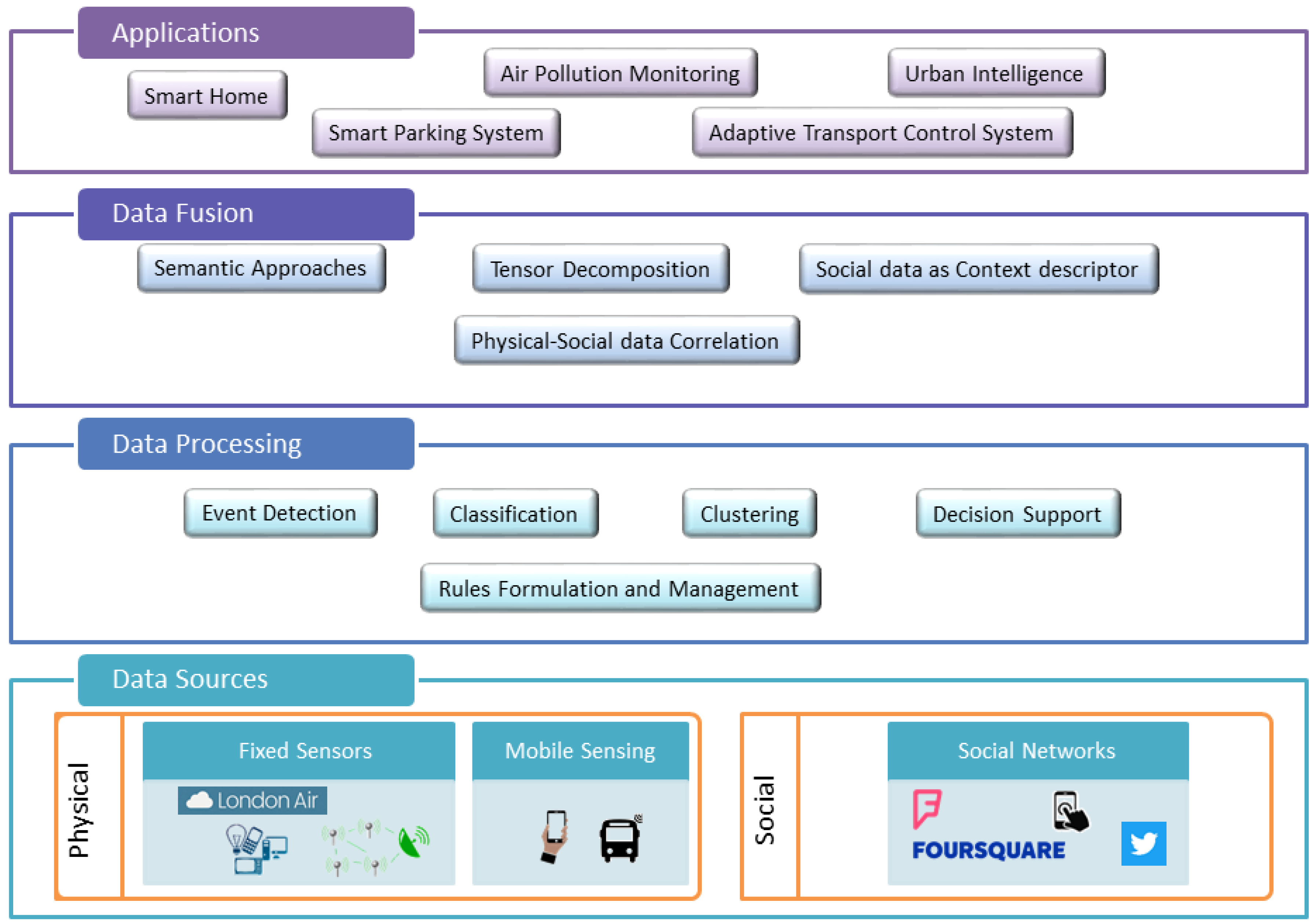
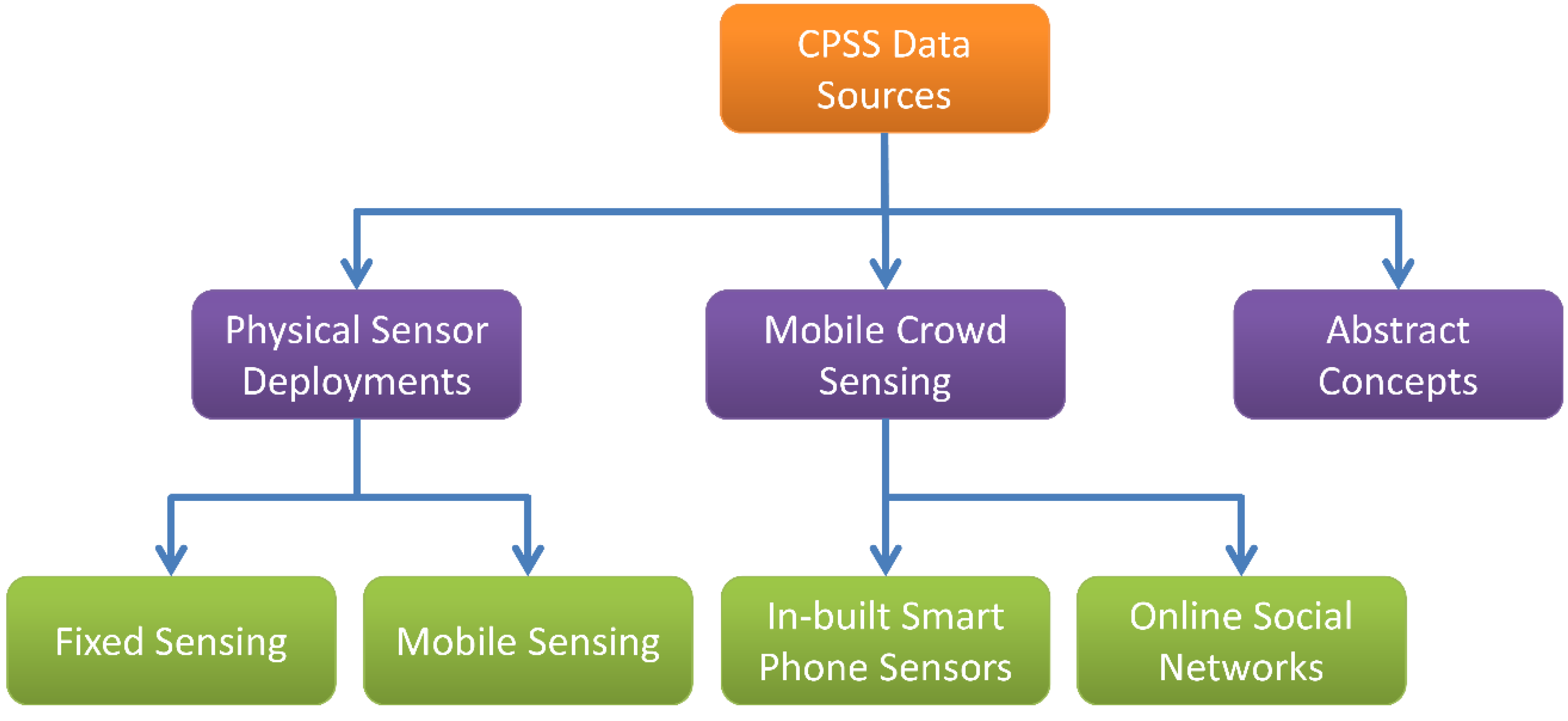

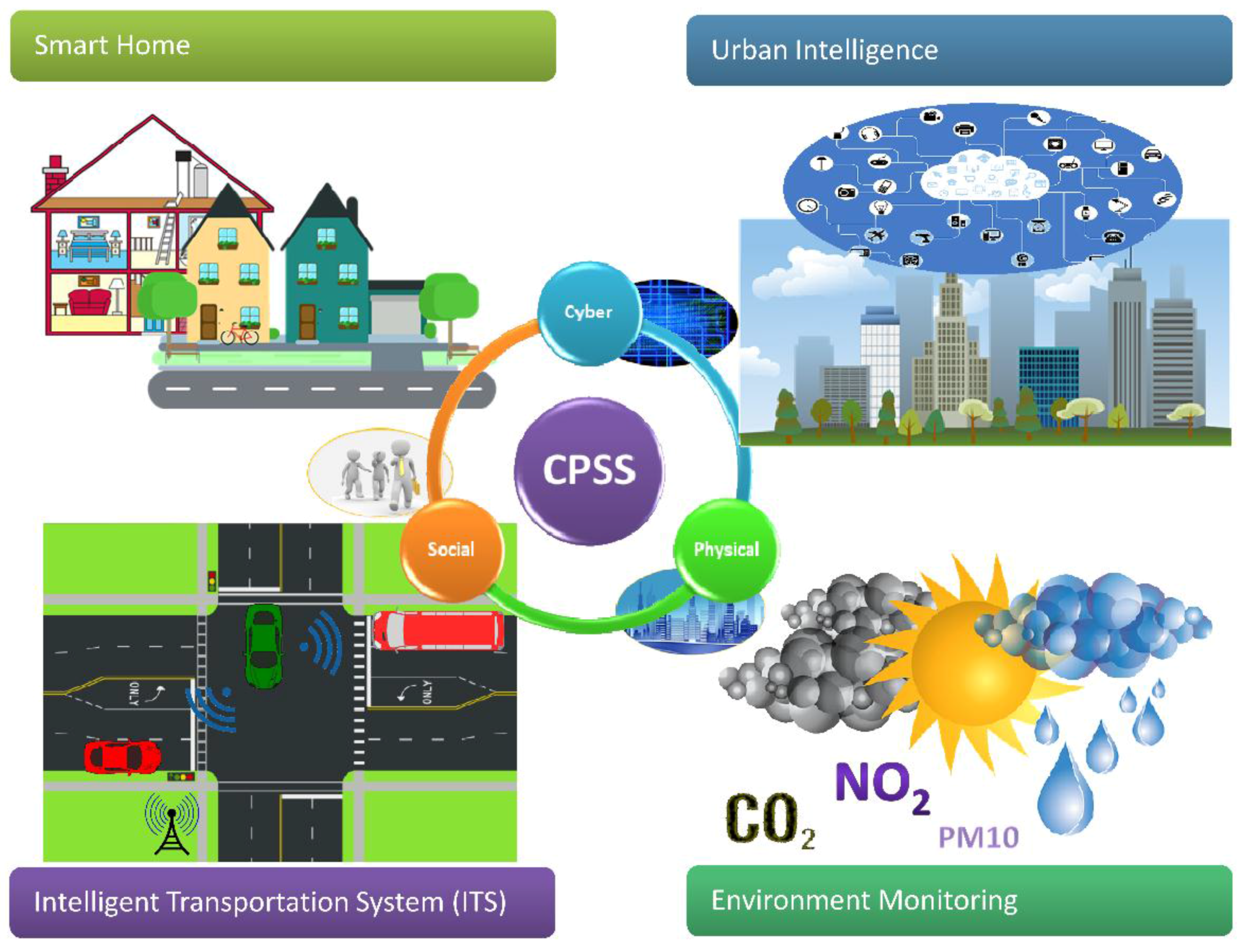
| Reference | System Components | Data Sources | Data Processing | Data Fusion | Applications |
|---|---|---|---|---|---|
| Wi-City-Plus [38,39] | Communication layer, monitoring layer, application layer, semantic layer | Environment monitoring data, weather data, user health data, Static information (city ontologies), Participatory sensing for traffic conditions | Fuzzy rules through SPARQL Protocol and RDF Query Language (SPARQL) | Semantics-based mobility and logistics recommendation | Decision support system for Event and path recommendation, Road incident alerts, Elderly care |
| Komninos et al. [57] | Social media cloud, Web-based Geographic Information System (GIS), Mobile/Web apps, Cloud-based service infrastructure | Foursquare check-ins, Traffic volume measurements, Pollutant levels | Diurnal cumulative average | Cross-space data correlation | Urban rhythm |
| J. Jin et al. [18] | Data collection, Data processing Data management Data interpretation | Fixed and mobile sensing infrastructure, Participatory sensing | Visualization of cloud stored data | - | Noise mapping |
| Jara et al. [63] | Data read, data cleaning, data selection and transformation, data integration, analysis and visualization | Traffic data, Temperature measurements | Data aggregation for global mean | Traffic patterns correlated with temperature | - |
| Noulas et al. [64] | - | Foursquare check-ins, call data records | Spatial clustering, supervised classification algorithm | Foursquare venue label correlated with cell tower location | Urban neighborhood activity characterization |
| Air quality assessment from social media [32] | - | Air pollution data Tweets | Association rules, clustering, classification of air pollution data Sentiment analysis from tweets | Air Quality Index (AQI) of air pollution data are combined with public opinion estimation through sentiment analysis of tweets | Public opinion estimation of Air Pollution |
| Yang et al. [65] | Air quality data Subjective air quality feeling Activity status data from wearable sensors Reported health symptoms | Computing of average of data | Regression analysis on different kinds of data | Public health and personal health | |
| Kuznetsov et al. [31] | Global Positioning System (GPS)-based air quality sensors deployed by different communities of people | Air quality data are analysed by different communities. People in different communities can check the data and give feedback. | By analyzing data in different communities, expressions in the communities are discussed. | Public activism analysis | |
| Guo et al. [40] | Resource management Cooperative sensing Data pre-processing Data analysis | Sensing data | Quality maintenance Redundancy elimination Conflict resolution Semantic representation | Cross-Space Data Fusion | - |
| GroRec [66] | - | Different aspects of data from social networks, including user behaviors, reviews, and ratings etc. | Tensor model for spatiotemporal user behaviors, clustering for group discovery | Tensor decomposition, Group behavior data fusion for group discovery Pearson correlation for friendships | Group recommendation |
| Kuang et al. [42] | - | User behavior, spatiotemporal context | Tensor model for video clips, user relationships, RDF documents | Tensor decomposition | Smart home |
| Wang et al. [67] | - | User and device context | Tensor model for relationships between users and devices | Tensor decomposition | Enhanced living environment |
| Candra et al. [68] | CPSS monitoring framework Thing-based systems Software-based systems Human-based systems | Human, Software, Things-related data | Quality of data evaluation | - | Quality aware data delivery |
| Dynamic Social Structure of Things [69] | User context and profile management, Semantic rule engine, Natural Language Processing (NLP) | User profile, Object capabilities modelled as social objects | Event retrieval, goal determination | Dynamic social structure of Things model generated through semantic reasoning Object and service relevance | Smart Airport |
| Smirnov et al. [55] | - | - | Ontology modeling of physical, cyber and human spaces of a CPSS | - | Self-organizing resource network |
| Szabó et al. [70] | Streaming and persistence Serialization and caching Mobile data processing framework User defined functions | Participatory sensing data | Anomaly detection Visualization | - | Live transit feed Smart campus |
| Difallah et al. [71] | Water sensors Stream-processing subsystem array database management system | Real-time water sensing data | Local Indicators of Spatial Association (LISA) for Anomaly detection | - | Water Distribution Networks monitoring |
| Star-City [72] | Data access Data transportation | Weather conditions Bus data stream Social media feeds Planned events and roadworks Static city map | Spatiotemporal data analysis by SWRL (http://www.w3.org/Submission/SWRL/) rules | Semantic reasoning | Traffic prediction |
| CityPulse [56] | Large scale data stream processing modules Adaptive decision support modules | (near) real-time IoT data Social media data streams | Event detection Semantic Modeling Reasoning | Complementary interpretation | Travel planner Parking monitoring |
| SmartSantander [14,73] | IoT node tier IoT gateway tier Server tier | Environmental sensing data Parking Agriculture sensing data Participatory sensing | - | - | Environmental monitoring Parking management Participatory sensing etc. |
| CleanSpacce [74] | - | Pollution Temperature | Simple aggregations of pollution levels | Sensor information from all the users is combined based on location to create a map of the city | Personal journey optimization |
| Sentilio/Barcelona [75] | Apps Data Processing Agents Realtime Storage Security/Governance/Monitoring Catalog Providers | Smart meters smart bins location sensors in public transport sensors in the asphalt to detect parking spaces air quality sensors irrigation and water levels | Rules on sensor data (methods not disclosed) | - | Urban optimization, street lights, parking spaces, energy savings |
| SmartThings [76] | Application Management Event Stream Layer Connectivity Layer API Layer | Lights and Switches Outlets Motion Sensor Moisture Sensor Door/window sensor Camera/door locks | Rule engine conditions on sensors | Sensor information can be combined in different ways to create rules. External systems can also be integrated directly. | Smart Home control |
| Nest [77] | Service Layer (details not disclosed) API Layer | Thermostat/Temperature Sensors Smoke/CO sensors Presence sensor Energy Peaks | Machine learning from usage (method not disclosed) Rules on alerts | Combines data in the household to learn about habits and configures the thermostat accordingly. | Smart Home optimization, energy savings |
| W. Guo et al. [19] | Perception, communication, computing, control, application | V2I data, parking system sensors (cameras, infrared sensors), mobile sensors | Person trip intent derivation | Trip intent to influence traffic control system | Smart parking, adaptive traffic control |
| Delmastro et al. [78] | Client side app, Server side | Qualitative environment data, traffic data posted by users, personal activity data | - | - | Participatory sensing platform |
| Anagnostopoulos et al. [36] | Client side app, Server side | Sensing data from smart phones (GPS, time, velocity and direction) | Different sleep models for energy efficiency | - | Intelligent traffic light control for cyclists |
| Zhou et al. [33] | Client side app, Server side | Bus information streams, Passenger GPS traces, Points-of-Interest (POI) data | Density-based clustering, Different prediction models for passenger demand | - | Bus passenger demand prediction |
| MetroSense [79] | Server Tier, SAP (Sensor Access Point) Tier, Sensor Tier | Static and mobile sensors | Sensor data mining, Sensor data anomaly detection | - | People-centric Urban Sensing enabling |
| Smirnov et al. [11] | Physical level, planning level, strategic level | Ontology modeling of sensors and actuators (vacuum, cleaning robot) | Ontology matching | - | Smart home cleaning scenario |
© 2017 by the authors. Licensee MDPI, Basel, Switzerland. This article is an open access article distributed under the terms and conditions of the Creative Commons Attribution (CC BY) license (http://creativecommons.org/licenses/by/4.0/).
Share and Cite
De, S.; Zhou, Y.; Larizgoitia Abad, I.; Moessner, K. Cyber–Physical–Social Frameworks for Urban Big Data Systems: A Survey. Appl. Sci. 2017, 7, 1017. https://doi.org/10.3390/app7101017
De S, Zhou Y, Larizgoitia Abad I, Moessner K. Cyber–Physical–Social Frameworks for Urban Big Data Systems: A Survey. Applied Sciences. 2017; 7(10):1017. https://doi.org/10.3390/app7101017
Chicago/Turabian StyleDe, Suparna, Yuchao Zhou, Iker Larizgoitia Abad, and Klaus Moessner. 2017. "Cyber–Physical–Social Frameworks for Urban Big Data Systems: A Survey" Applied Sciences 7, no. 10: 1017. https://doi.org/10.3390/app7101017
APA StyleDe, S., Zhou, Y., Larizgoitia Abad, I., & Moessner, K. (2017). Cyber–Physical–Social Frameworks for Urban Big Data Systems: A Survey. Applied Sciences, 7(10), 1017. https://doi.org/10.3390/app7101017






